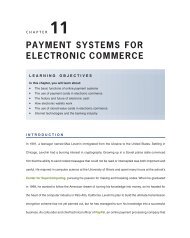ELECTRONIC COMMERCE SOFTWARE
ELECTRONIC COMMERCE SOFTWARE
ELECTRONIC COMMERCE SOFTWARE
Create successful ePaper yourself
Turn your PDF publications into a flip-book with our unique Google optimized e-Paper software.
424<br />
Chapter 9<br />
The distinction between midrange and large-scale electronic commerce software is<br />
much clearer than the one between basic systems and midrange systems. The telltale sign<br />
is price. Other elements, such as extensive support for business-to-business commerce,<br />
also indicate that the software is in this category. Commerce software in this class is sometimes<br />
called enterprise-class software. The term “enterprise” is used in information systems<br />
to describe a system that serves multiple locations or divisions of one company and<br />
encompasses all areas of the business or enterprise. Enterprise-class electronic commerce<br />
software provides tools for both B2B and B2C commerce. In addition, this software<br />
interacts with a wide variety of existing systems, including database, accounting, and ERP<br />
systems. As electronic commerce has become more sophisticated, large companies have<br />
demanded that their Web sites and supporting information infrastructure do more things.<br />
The cost of these enterprise systems for large companies ranges from $200,000 for basic systems<br />
to $10 million and more for comprehensive solutions.<br />
Enterprise-Class Electronic Commerce Software<br />
Enterprise-class electronic commerce software running large online organizations usually<br />
requires several dedicated computers—in addition to the Web server system and any necessary<br />
firewalls. Examples of enterprise-class products that can be used to run a large online<br />
business with high transaction rates include IBM WebSphere Commerce Business<br />
Edition, Oracle E-Business Suite, and Broadvision One-To-One Commerce.<br />
Enterprise-class software typically provides good tools for linking to and supporting supply<br />
and purchasing activities. A large part of B2B commerce is ordering supplies from trading<br />
or business partners and issuing the appropriate documents, such as purchase orders.<br />
For a selling business, e-business software provides standard electronic commerce activities,<br />
such as secure transaction processing and fulfillment, but it can also do more. For<br />
instance, it can interact with the firm’s inventory system and make the proper adjustments<br />
to stock, issue purchase orders for needed supplies when they reach a critically<br />
low point, and generate other accounting entries in ERP, legacy accounting, or file systems.<br />
In contrast, both basic and midrange electronic commerce packages usually require an<br />
administrator to check inventory manually and place orders explicitly for items that need<br />
to be replenished.<br />
In B2C situations, customers use their Web browsers to locate and browse a company’s<br />
catalog. For electronic goods (software, research papers, music tracks, and so on), customers<br />
can download the items directly from the site, or they can complete order forms<br />
and have the hard-copy versions of the products shipped to them. The Web server is linked<br />
to back-end systems, including a database management system, a merchant server, and an<br />
application server. The database usually contains millions of rows of information about<br />
products, prices, inventory, user profiles, and user purchasing history. The history provides<br />
a way to recommend to a user on a return visit related items that he or she might wish<br />
to purchase. A merchant server houses the e-business system and key back-end software.<br />
It processes payments, computes shipping and taxes, and sends a message to the fulfillment<br />
department when it must ship goods to a purchaser. Figure 9-14 shows a typical<br />
enterprise-class electronic commerce architecture.<br />
As you learned in Chapter 4, companies are storing data about site visitors in large databases<br />
and analyzing it to improve their relationships with those customers. These clickstreams<br />
track the path a visitor takes through a Web site, including which pages were



